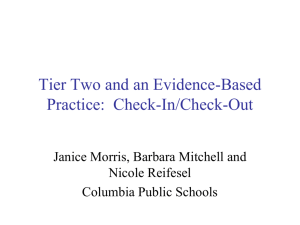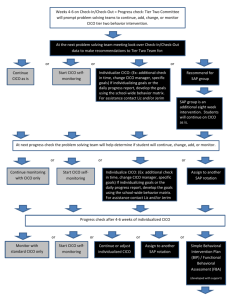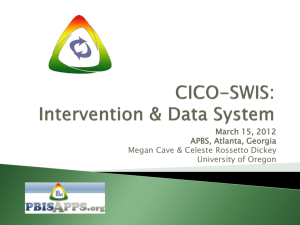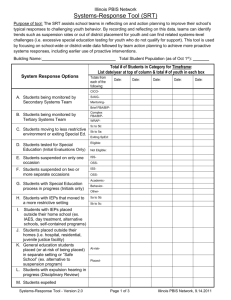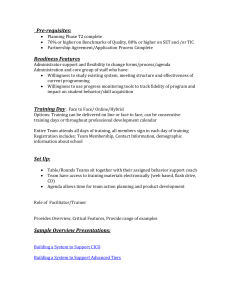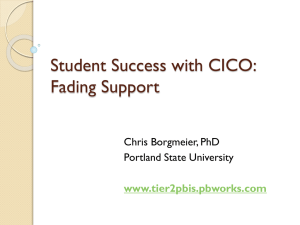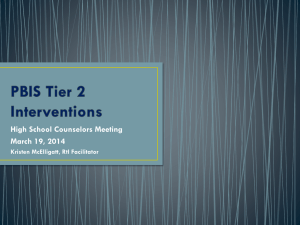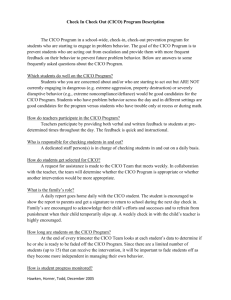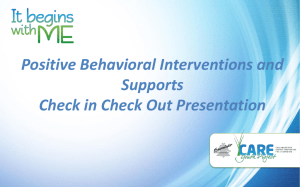8/12/2014 Tier 2 Practices – Rundlett Middle School
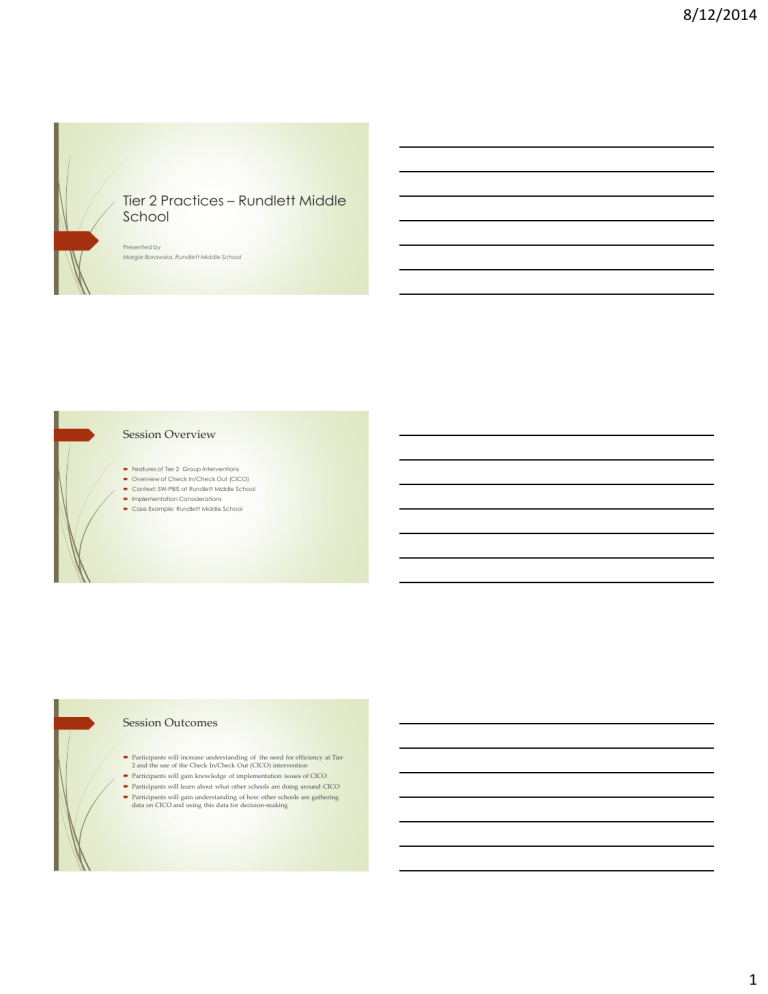
Tier 2 Practices – Rundlett Middle
School
Presented by
Margie Borawska, Rundlett Middle School
Session Overview
Features of Tier 2 Group Interventions
Overview of Check In/Check Out (CICO)
Context: SW-PBIS at Rundlett Middle School
Implementation Considerations
Case Example: Rundlett Middle School
Session Outcomes
Participants will increase understanding of the need for efficiency at Tier
2 and the use of the Check In/Check Out (CICO) intervention
Participants will gain knowledge of implementation issues of CICO
Participants will learn about what other schools are doing around CICO
Participants will gain understanding of how other schools are gathering data on CICO and using this data for decision-making
8/12/2014
1
The Need for Tier 2 Interventions &
Supports:
Middle/High School Model: Positive Behavior Interventions &
Supports
& RENEW
Malloy, Agorastou & Drake, 2009 Adapted from Illinois PBIS Network,
Revised Sept., 2008 & T. Scott, 2004
Defining Features of Tier II Interventions
Typically group based
Consistent, standardized implementation across students
Easily accessible (within a few days of referral)
Continuous availability
Implemented by all school staff
Consistent with and provide extra exposure to school wide behavioral expectations
*Adapted from Crone, Horner, & Hawken, 2004; Hawken & Horner, in press; March &
Horner, 2002
8/12/2014
2
The 4 E’s of Targeted Group Interventions
Efficient
Effective
Evidence Based
Early
Ensures efficient and effective supports are made available for students that DO NOT require a lot of time & resources
Effective Practices for Evidence Based Tier
II Interventions
Targeted
Skill
Instruction
Plan for
Mainten ance
Acknowled gement
of
Appropriate
Behav ior
Increased
Performance
Feedback
Increased
Adult Support
Purpose of Tier 2 Interventions
Prevent or decrease problem behaviors
Ensures effective and efficient supports are made available for students who DO
NOT require a lot of time & resources
Group intervention is matched to ‘functions’ of behavior and need
8/12/2014
3
Critical Features of CICO
Well researched, standardized practice
Direct link to school-wide behavioral expectations
Student nomination
Daily Behavioral Score Card
Data based decision making to monitor students’ progress
Scheduled 4-6 sessions
Accommodates groups of students
Home-school Communication
Increased adult support & feedback
System Essentials
CICO Coordinator (T2 Team Liaison) and Coach(es)
Orientation for staff and students
Commitment to Implementation with Fidelity
Data reviews:
Efficacy
Fidelity of implementation
Multi-phased capacity:
CICO with AM/PM Group Meeting or without
CICO-plus or self-monitoring
Adaptable to Cultural Fit
Coordinators are KEY!
“
The coordinator must be someone who the students respect, enjoy, and trust.
This person should be enthusiastic, positive, and friendly”
-Crone, Hawken, & Horner, 2010
8/12/2014
4
Example of Nominating Criteria
● Student demonstrates mild to moderate risk for social and/or academic disengagement or failure as demonstrated by inconsistent academic performance and frequent minor behavioral concerns.
– The reason for risk is NOT primarily due to a skill deficit that would require remediation in order to expect better performance.
– Student is not at high risk for disengagement or failure and/or is not engaging in severe or dangerous behaviors.
–
–
Student is not diagnosed with a serious emotional disturbance.
Student is not diagnosed with a behavioral disorder (e.g., oppositional-defiant disorder).
● There is reason to expect that the student will be responsive to positive adult attention.
● Nominating teacher(s) estimates that IF this student were to achieve 80% of total points on a CICO Daily Report Form, that this would demonstrate improvement/ progress.
Small Group Discussion: What is the
Function of the Behavior?
Ben is an 8 th grader who has been having behavioral difficulties throughout his middle school career (multiple office discipline referrals, multiple suspensions), mostly for disrupting class and responding inappropriately to teachers’ reasonable requests. Ben has received Ds and F’s in math and science and C’s in most of his other core academic classes. He is athletic and artistic. Ben likes to talk to peers when the teacher is lecturing, and he does not do any work when given independent tasks. He reacts defensively and inappropriately when corrected by the teachers.
PBIS at Rundlett Middle School
8/12/2014
5
Timeline: Exploration and Installation-
2010-11
1.
2.
3.
4.
5.
6.
7.
Identified a problem between staff and student expectations around behavior
Explored schools using systems such as PBIS
Representative from PBIS explained to the staff how PBIS works
Staff received additional workshop time to check for understanding on
PBIS before the staff voted
83% of staff voted to bring in PBIS- May 2011
Staff from all over the building encouraged to apply to be part of the
PBIS Universal Team (included administration, teachers, paraprofessionals, and parents)
PBIS Universal Team met over the summer of 2011 with a PBIS Coach to establish meeting norms and establish job criteria of the group
D
Rundlett MS Behavior Matrix
Do your own work
Recognize and support the good work of others
Report problems to an adult
In the Classroom
Keep Trying
Seek help when needed
Finish what you start
Maintain a positive attitude
Use appropriate language and voice level
Respond positively to reasonable requests
Be considerate of others’ learning and feelings
Take care of school property and your learning materials
In the Hallway
•
Prepare yourself for class quickly
Use appropriate language and voice level
Keep hands and feet to yourself
Make room for others to pass
Be considerate of others’ feelings
Help others in need
Report problems to an adult
In the Bathroom/
Locker room
Use appropriate language and voice level
Clean up after yourself
Flush!
Place personal items in the proper receptacle
Keep walls & stalls clean
Give others privacy
Report problems to an adult
Be on time
Be on task
Be prepared
Be organized
Do your best work
•
•
Listen to learn and understand
Keep classroom neat and
•
• clean
Engage in your learning
Walk
Keep to the right
Go directly to your
• destination
Keep locker closed
Keep walls, lockers, and floors clean
Consistently follow routines
Return to room promptly
In the Cafeteria
•
Be patient as you wait your turn in line
Use appropriate language and voice level
Clean up after yourself
Listen to announcements
Keep hands, feet, and food to yourself
Be considerate of
• others’ feelings
Pay for and consume your own
• food and drink
Support and include one another
• Report problems to an adult
Consistently follow routines
Honor personal
• space
Walk
Leave your area clean
•
•
•
•
Arrival to and Departure from school
Be patient as you wait
Stay in assigned area
Seek help when needed
Remove headphones from your ears before entering the building
Use appropriate language and voice level
Respond positively to reasonable requests
Keep hands and feet to yourself
Remove hats and silence phones when entering the building
Be considerate of others’ feelings
Always walk
Support and include one another
Leave the street at the door
Report problems to an adult
• Follow the arrival and dismissal
• procedure
Enter and exit the building through the designated door
Sit in your seat when on the bus
•
Leave your area clean
• Follow all bus rules
8/12/2014
6
RMS ODRS/100 students/day
SW PBIS
Implementation begins
14
12
10
8
2
0
6
4
200
150
100
50
0
250
RMS Suspensions
OSS OSS Days # Students
8/2011-3/2012
8/2012-3/2013
8/2013-3/2013
Tier 2 at RMS: Behavior Intervention
Team or BIT
The mission of the RMS Behavior Intervention Team (BIT) is to provide additional, practical, organized and timely support to students in conjunction with PBIS Universal school-wide systems. This team will also serve as a support system for faculty in guiding these students to make behavioral progress in school-wide settings. (BIT, 2011).
History of the team:
Preceded PBIS implementation
Primarily individualized FBA and BEPS before 2011
Instituted eligibility/exit criteria, small group interventions, and systemativ data collection since 2012
8/12/2014
7
RMS Tier 2 Nominating Criteria
____ Absences (5 days out in a quarter)
____ Frequent Tardy/Dismissal to/from school (2 or more per week)
____ Frequent Tardy to class (more than 5 minutes – major office referral)
____ Office Discipline Referrals (3 ODRs resulting in 6 days out of class (ISS &/or OSS))
____ Nurse Visits
____ Academic Failure
Check-In/ Check-Out Procedures:
Student Orientation
Reason for providing the regular feedback
Student and staff/student responsibilities
Orient students to what constitutes a ‘reminder’ (scoring)
Teacher provides feedback at the end of class (mutual responsibility)
Last period teacher and student briefly review card at end of day
the desired behaviors)
CICO Coach-Teacher Orientation
Coach and classroom teacher(s) meet to review program, procedures & forms
Address specific concerns the teacher(s) has about the program per the student.
Teacher(s) practices providing greeting, feedback and end-of-day review.
Parent notification is addressed
8/12/2014
8
Implementing Greetings and Feedback with Fidelity
Importance of Fidelity of Implementation
– Only way to reliably know if a strategy works
Greetings and feedback are brief ( 20 seconds) and positive
1.
2.
3.
4.
Display behaviors that you use when you are glad to see someone
Smile
Be present with student
Positive contact – does not need to be praise
Non-reprimanding
1.
a)
CICO is NOT designed for focus on what went wrong or for reprimand
Research is clear that repeated reprimands for students with repeated misbehavior are increased disengagement, disconnection or feelings of anger or hopelessness
End of day review DOES require:
1.
2.
3.
4.
A quick add-up of points
A statement of achieving or not achieving the standard goal
A quick and encouraging reminder of the behaviors that will allow student to achieve the goal tomorrow
A friendly good-bye
CICO
Procedures: Schedule Review Meeting
CICO Lead/Coach coordinates date and time for review meetings
Coach should do a quick check-in with teachers after a week to pre-empt major problems
The first review meeting should occur approximately 5 weeks (20 school days) following the first day on the program
CICO Procedures:
Steps for End of Day Review
At the end of the school day:
1.
Quick review and add-up points.
2.
Write the total number and % achieved for the day.
3.
State the total and whether the daily goal was met. a) b)
If the student achieved the daily goal, provide verbal acknowledgement.
If goal was not achieved, verbally acknowledge any strengths and encourage positive performance for tomorrow.
4.
Stay present with student (approx. 1 minute)
5.
Respectful/ Friendly good-bye
8/12/2014
9
CICO
Procedures:
Cards Submitted for Data Entry
Each day, the student’s last period teacher puts the completed card(s) in designed spot for data entry.
CICO: Assessing Progress
Data are reviewed for:
1.
Efficacy of the intervention
2.
Fidelity of implementation
Decision for next step is made. Typically:
1.
Repeat for another session with no change
2.
Repeat with adjustment or self-monitoring
3.
Discontinue due to success and expectation for sustainability
4.
Discontinue with thoughts for different support
8/12/2014
10
8/12/2014
Benefits of score card
For staff
Reminder for specific feedback to student
For student
Reminder of schedule for day
Reminder of specific behavioral expectations and goals for the day
A ‘ticket’ for self-recruiting feedback from teachers and parents
Progress monitoring tool
For school
Provides data for data entry for student monitoring and program monitoring
Communication
11
CICO: Implementation Questions
Why & how CICO works?
Frequently asked questions about the CICO Program
Which students do well on the CICO Program?
How do teachers participate in the CICO Program?
Who is responsible for checking in and out with students in the am/pm?
How do students get nominated for CICO?
What is the family’s role?
How long are students enrolled in the CICO Program?
What do students do with their earned points?
What about the data?
Efficient procedures for providing data
Efficient procedures for entering, summarizing and reporting data
Efficient methodology for assessing progress/success
Ongoing evaluation procedures to assess fidelity of implementation
Highlights from Rundlett Middle School
Implementation issues
The data tells the story
Lessons learned
Next Steps
Tools to share ( parent letter, student referral form, protocols, score card, etc)
8/12/2014
12
6
4
2
0
CICO data Oct ‘13 – Dec ‘13
Total of 27 students
3 CICO Coordinators
Average Daily CICO Points
14
12
10
8
80% and above 50% - 80% below 50 %
Are we implementing CICO with fidelity?
30% of students were meeting their 80% goal
48% of students were between 50 to 80% - WHY?
Upon further consideration of anecdotal data, it was concluded that
There were differences in how CICO Coordinators completed Check In/Check Out procedures
There were differences in type and frequency of reinforcement activities among CICO
Coordinators
The primary concern for 5 students in the 50-80 % range related to difficulties with organization
NEXT STEPS…
Addressing Areas of Concern
Concerns related to differences in implementation of CICO among CICO
Coordinators were addressed through additional training and oversight
Similarly, concerns related to frequency and reinforcement were addressed
Students who primarily presented with organizational concerns were enrolled in 3S class
4 students in the 50% and below range presented with significant needs and ended up being referred for more intense services (i.e. consideration for special education)
8/12/2014
13
CICO data Jan‘14 – March‘14
Total of 30 students
Average Daily CICO Points
20
18
16
8
6
4
2
0
14
12
10
80% and above 50% - 80% below 50 %
3 S Class (Student Skills for Success)
Purpose:
To ensure academic and social/emotional success of students by providing organizational instruction and support, academic support (homework and assignment completion), instruction to develop self-determination skills, and support students to take ownership of their learning. (Derived from Swain-Bradway,
Behavior Education Program, 2011).
Eligibility
6 th , 7 th , 8 th grade students
Students not responding to CICO
4-6 weeks of non-response
Absences of concern (Grade level secretaries)
ODR’s (Counselors/Admin)
Failures (Counselors/Admin)
Tardiness (Grade Level Secretaries)
Completed Functional Behavioral Assessment to determine match for 3 S
3 Components of 3 S
Organizational Skills (40%)
-Self-monitoring/ goal setting
-Problem-solving
-Development of self-awareness (understanding one’s strengths and needs)
-Self-advocacy
- Assignment Notebook
8 Week Project 30%
-Student Driven
- Can be provided through 21C
- Based on Student Interest
-Includes a demonstration of knowledge gained
Behavior 30%
-CICO Point Sheet (Improvement)
-Self- Monitor
-Goal Setting
8/12/2014
14
Resources for Implementing the BEP
Crone, Horner, & Hawken (2004).
Responding to Problem Behavior in
Schools: The Behavior Education
Program . New York, NY: Guilford
Press
Hawken, Pettersson, Mootz, &
Anderson (2006). The Behavior
Education Program: A Check-In, Check-
Out Intervention for Students at Risk.
New York, NY: Guilford Press
Thank you!
Margie Borawska,
Rundlett Middle School
mbora@concordnhschools.net
JoAnne Malloy,
Institute on Disability
University of New Hampshire
Joanne.malloy@unh.edu
8/12/2014
15
